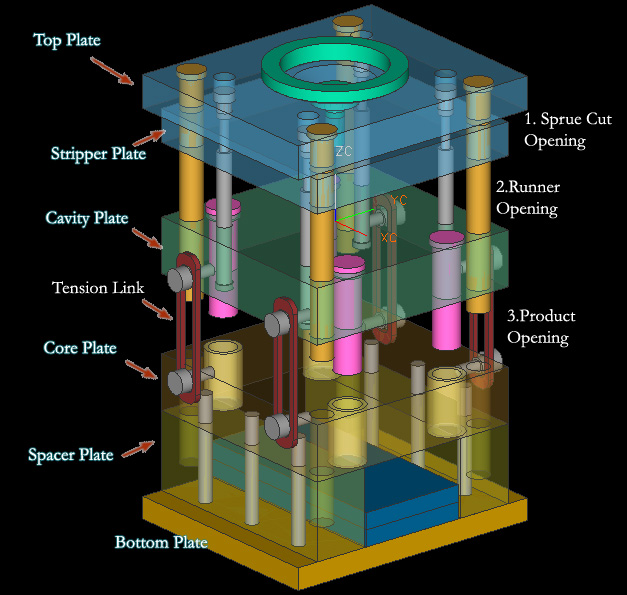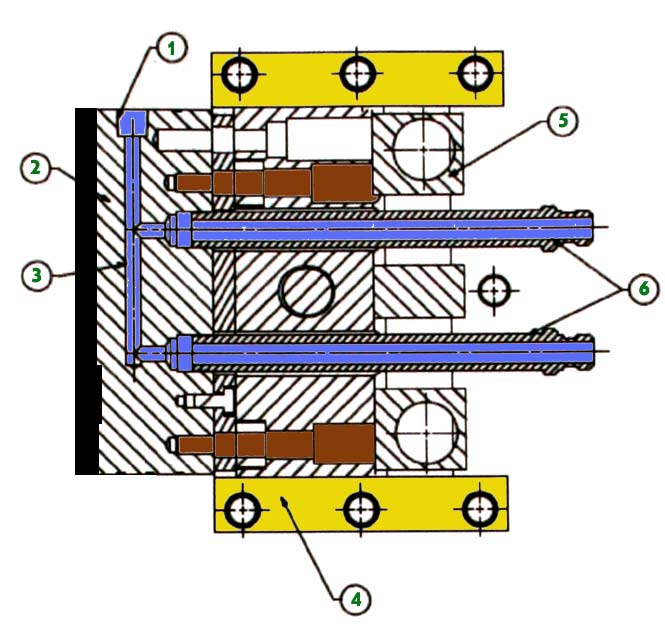Jetting occurs when polymer melt is pushed at a high velocity through restrictive areas, such as the nozzle, runner, or gate, into open, thicker areas, without forming contact with the mold wall. The buckled, snake-like jetting stream causes contact points to form between the folds of melt in the jet, creating small-scale "welds".
Jetting leads to part weakness, surface blemishes, and a multiplicity of internal defects. [1]
Mainly Caused by
Excessive ram speed,
Poor gate position
,Lack of melt contact with the mold allows jetting to occur,
Inadequate hot runner system design
Excessive Injection Speed
Explanation: Excessive injection speed (fill rate) will cause the molten plastic to form jet streams as it is pushed through the gates instead of the more desirable wide "tongue'' of material. These snake-like streams cool independently from the surrounding material and are visible on the molded part surface.
Solution: Reducing the injection speed will allow the plastic flow front to stay together and not form the individual streams that cause the jetting patterns on the part surface.
Barrel Temperature Too High or Too Low
Explanation: When barrel temperatures are too low, the material will not be heated to the proper temperature for adequate flow. The material will push slowly into the mold and the flow front will break up into individual streams as resistance builds up. This will cause jetting patterns. On the other hand, if the barrel temperature is too high, the material is pushed into the mold too quickly. This causes the flow front to split apart as it enters the cavity and the jetting patterns will develop.
Solution: Decrease or increase the barrel temperature accordingly. The material supplier can recommend the best starting point for barrel temperature and it can be adjusted from that point. Make changes in 10 degree F increments and keep the profile so it is heating progressively from back to front.
Small Nozzle Opening
Explanation: If the nozzle opening (or sprue bushing opening) is too small for the material being molded, the restriction may cause the material to flow too slowly and solidify early. The flow front may break apart as it travels through the gate (due to sidewall friction) and jetting patterns may develop.
Solution: Increase the nozzle opening. As a general rule, the nozzle opening should never be less than 7/32'' in diameter. The stiffer the material flow, the larger that opening should be. Make sure that the sprue bushing opening diameter matches or is 1/32'' larger than the nozzle opening.
Low Nozzle Temperature
Explanation: As material is transported through the heating barrel, it is gradually brought up to the ideal processing temperature by absorbing heat from the heating bands and frictional heat, which is created by the shearing action of the rotating screw within the barrel. In the last heating zone, the material is exposed to is the nozzle. By the time the material gets to the nozzle, it should already be at ideal molding temperature and only a small amount of heat needs to be applied at this point to keep the resin flowing. If the nozzle is not hot enough, however, the material will begin to cool off too quickly as it leaves the barrel and the flow front will not flow properly, breaking into many streams and causing jetting.
Solution: Increase the nozzle temperature. As a rule-of-thumb the nozzle temperature should be set at 10 degrees F higher than the setting for the front zone of the barrel. This helps compensate for heat loss due to metal-to-metal contact between the nozzle and the sprue bushing and keeps the material hot enough to flow properly, eliminating jetting.
MOLD
Low Mold Temperature
Explanation: Generally, a hot mold will allow a material to stay molten longer than a cold mold and cause the molecules to pack together properly before they solidify. This results in a dense part with no separation of layers. If the mold is too cold, the molecules solidify before they are packed together and may break up into separate units. As they travel through the gate these units split up and form jetting patterns on the part surface.
Solution: Increase the mold temperature to the point at which the material has the proper flow and packs out the mold without jetting. Start with the material suppliers recommendations and adjust accordingly. Allow 10 cycles for every 10-degree change for the process to re-stabilize.
Small Gates and/or Runners
Explanation: Gates and/or runners that are too small will cause excessive restriction to the flow of the molten plastic. Many plastics will then begin to solidify before they fill the cavity. The result is an unpacked condition and the flow front may break into separate streams, causing jetting patterns to develop.
Solution: Examine the gates and runners to determine if any burrs or other obstructions exist. If possible, perform a computer analysis to determine the proper sizing and location of gates and runners. Ask the material supplier for data concerning gate and runner dimensioning for a specific material and flow rate.
Improper Gate Location
Explanation: If certain materials are injected directly across a flat cavity surface they tend to slow down quickly as a result of frictional drag and cool off before the cavity is properly filled. As the material tries to flow through the gate, it is pulled apart into several streams and this forms a jetting pattern on the part.
Solution: Relocate, or redesign, the gate so that the molten plastic is directed against an obstruction such as a core pin. This will cause the material to disperse and continue to flow instead of slowing down.
Excessive Gate Land Length
Explanation: The area that surrounds the gate itself is called its land. It determines the distance a material must travel in a restricted state immediately before it enters the cavity. The length of this travel (land) should be no more than 1/8''. The land acts like a tunnel when the mold is closed and if the tunnel is too ling the material begins to cool off before it can get to the cavity. This causes the material to split into streams that create the familiar jetting pattern on the part.
Solution: Decrease the gate land length. It is best to construct the mold so that the gates are located in replaceable inserts. That way they can be replaced easily at times when adjustments are needed. The insert should include the land area. This land length should be no less than 0.030'' and no greater than 0.125''.
MATERIAL
Improper Flow Rate
Explanation: Resin manufacturers supply specific formulations in a range of standard flow rates. Thin-walled products may require an easy flow material while thick-walled products can use a material that is stiffer. It is better to use as stiff a flow as possible because that improves physical properties of the molded part. But, the stiff material will be more difficult to push and this may result in a breakup of the flow front as the material enters the gate. The breakup appears as a jetting pattern.
Solution: Utilize a material that has the stiffest flow possible without causing jetting. Contact the material supplier for help in deciding which flow rate should be used for a specific application.
OPERATOR
Inconsistent Process Cycle
Explanation: It is possible that the machine operator is the cause of delayed or inconsistent cycles. This will result in erratic heating of the material in the injection barrel. If such a condition exists, the colder particles may not fill the mold before they fully solidify. Jetting may be caused as these colder areas attempt to push through the gate and are torn apart due to sidewall friction.
Solution: If possible, run the machine on the automatic cycle, using the operator only to interrupt the cycle if an emergency occurs. Use a robot if an ``operator'' is necessary. In addition, instruct all employees on the importance of maintaining
Reference
1. BASF, Injection Moudling Process Solution, Mold Problem Catalog
2. Robert A.M Plastic Part Design for Injection Mould, an Introduction, Hanser
3. Misumi Tech Central : http://www.misumi-techcentral.com/tt/en/mold/2010/02/031-jetting.html
4. Injection Molding Guide : http://www.kenplas.com/service/imtroubleshooting.aspx
5. Sabiq Innovative Plastic
6. Various journal from Elsevier




















